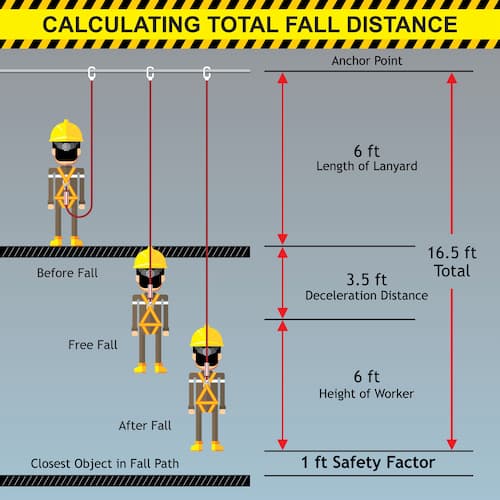Understanding Clearance For Fall Arrest Systems
When you're working at heights, understanding fall clearance isn't just a matter of compliance—it's a matter of life and death. As a construction worker or safety manager, you need to know how to calculate the safe distances for fall arrest systems. This knowledge could be the difference between a close call and a catastrophe.
Why Fall Clearance Matters to You
Imagine you're perched high above the ground, secured by your trusty fall arrest system. You feel safe, but have you considered what would happen if you actually fell? The distance between you and the nearest obstruction or the ground is critical. This is where fall clearance comes into play.
Fall clearance is the minimum vertical distance needed between the worker's feet and the nearest lower level or obstruction. It ensures that if you fall, your fall arrest system has enough room to deploy fully and arrest your fall before you hit anything.
Components of Fall Clearance You Need to Know
To calculate fall clearance accurately, you need to understand its components:
- Free Fall Distance: This is how far you fall before your personal fall arrest system begins to arrest the fall. OSHA limits this to 6 feet (1.8 m) or less. - OSHA Reference
- Deceleration Distance: Once your fall arrest system activates, it needs distance to slow your fall. This is typically 3.5 feet (1.1 m), but always check your equipment specifications.
- Harness Stretch: When you fall, your harness stretches. This is usually about 1 foot (0.3 m).
- D-Ring Shift: The D-ring on your harness will shift upward in a fall. Account for about 1 foot (0.3 m).
- Safety Factor: Always add a safety factor to your calculations. A common safety factor is 2 feet (0.6 m).
How to Calculate Your Fall Clearance
Now that you understand the components, here's how you calculate your required fall clearance:
- Start with your Free Fall Distance (FFD)
- Add your Deceleration Distance (DD)
- Add Harness Stretch (HS)
- Add D-Ring Shift (DRS)
- Add your Safety Factor (SF)
The formula looks like this:
Let's put this into practice with an example:
- Your lanyard allows for 5 feet of free fall
- Your shock absorber has a 3.5-foot deceleration distance
- You account for 1 foot of harness stretch
- You allow 1 foot for D-ring shift
- You add a 2-foot safety factor
5 + 3.5 + 1 + 1 + 2 = 12.5 feet
In this scenario, you need at least 12.5 feet of clearance below your working level to ensure your safety.

Additional Factors You Should Consider
While the basic calculation is straightforward, there are other factors you need to keep in mind:
- Swing Fall: If you're not working directly under your anchor point, you could experience a swing fall. This can significantly increase your required clearance.
- Elongation of Lifelines: If you're using a horizontal lifeline, you need to account for its sag and elongation during a fall.
- Sloped Surfaces: When working on a sloped surface, you'll need more clearance as you could slide further during a fall.
- Multiple Workers: If multiple workers are using the same system, you need to consider the impact on fall clearance if more than one person falls.
Your Responsibility in Ensuring Proper Fall Clearance
As someone working at heights, it's crucial that you:
- Understand Your Equipment: Know the specifications of your fall arrest system, including free fall distance and deceleration distance.
- Assess Your Work Area: Before starting work, evaluate the available fall clearance and potential obstructions.
- Use the Right Equipment: Choose fall protection equipment appropriate for your work situation and available clearance.
- Stay Vigilant: Continuously assess your fall clearance as you move around the worksite.
- Speak Up: If you're unsure about your fall clearance or notice potential issues, don't hesitate to voice your concerns.
Remember, understanding and properly calculating fall clearance isn't just about following rules—it's about ensuring you return home safely at the end of each workday. By taking the time to understand and apply these concepts, you're not just protecting yourself, but also setting an example for your colleagues and contributing to a culture of safety on your worksite.
Stay safe out there, and always keep an eye on your fall clearance!

